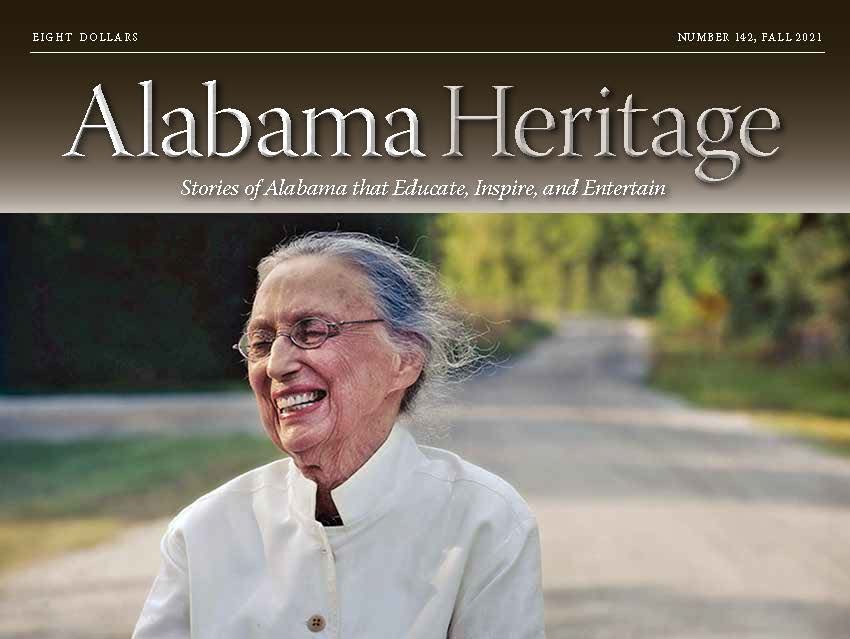
The Fall 2021 issue of Alabama Heritage magazine covers the life of short-story writer Mary Ward Brown who cultivated a worldwide literary reputation from the rich soil of Alabama’s Black Belt. Born in 1917, Brown was a literary late bloomer, publishing her first story at the age of thirty-eight, and her first short-story collection, Tongues of Flame, in 1986 at age sixty-nine. Mary struggled throughout life with the racially stereotyped words of her culture, which emotionally coincided with her memory but in time were discarded as part of the nation’s racist past.
Other features include archaeologists Stacye Hathorn and James P. Delgado covering the “finding” of Clotilda, an infamous ship’s legacy that lives on in the twenty-first century. Clotilda was a slave ship that lies twenty feet deep in the Mobile River. Its verified identification by a team of marine archaeologists has led to a renewed interest in nearby Africatown, settled after the Civil War by a group of the captives who were aboard the ship, including Cudjo Lewis.
Stephanie L. Robertson documents Lowe Mill Arts and Entertainment: an important part of Huntsville’s manufacturing history and an important Huntsville landmark. Lowe Mill has had many lives, but today it serves as studios for people to come see artists making their work and to speak to the artists.
Tim Pennycuff remembers Jimmy Hatcher, a showman of the South. Hatcher was a founder of Birmingham’s theatrical scene, he launched Broadway and Hollywood careers, and helped to found the Alabama School of Fine Arts. Jimmy Hatcher’s legacy continues to inspire even at the centennial of his birth.
Regular departments include Alabama Governors, From the Archives, Nature Journal, Reading the Southern Past book reviews, and more.
About Alabama Heritage
Alabama Heritage, celebrating its 35th year, is co-published by the University of Alabama, the University of Alabama at Birmingham, and the Alabama Department of Archives and History. The quarterly magazine covers a variety of subjects related to Alabama history and culture, and has garnered numerous local, regional, and national awards over the years. Copies are available for purchase at the University of Alabama Supply Store, at Barnes & Nobles and Books-a-Millions throughout the state, and online at www.alabamaheritage.com. Readers can also follow the magazine on Facebook, Twitter, Pinterest, Instagram, and YouTube.
Stephanie L. Robertson documents Lowe Mill Arts and Entertainment: an important part of Huntsville’s manufacturing history and an important Huntsville landmark. Lowe Mill has had many lives, but today it serves as studios for people to come see artists making their work and to speak to the artists.
Tim Pennycuff remembers Jimmy Hatcher, a showman of the South. Hatcher was a founder of Birmingham’s theatrical scene, he launched Broadway and Hollywood careers, and helped to found the Alabama School of Fine Arts. Jimmy Hatcher’s legacy continues to inspire even at the centennial of his birth.
Regular departments include Alabama Governors, From the Archives, Nature Journal, Reading the Southern Past book reviews, and more.
About Alabama Heritage
Alabama Heritage, celebrating its 35th year, is co-published by the University of Alabama, the University of Alabama at Birmingham, and the Alabama Department of Archives and History. The quarterly magazine covers a variety of subjects related to Alabama history and culture, and has garnered numerous local, regional, and national awards over the years. Copies are available for purchase at the University of Alabama Supply Store, at Barnes & Nobles and Books-a-Millions throughout the state, and online at www.alabamaheritage.com. Readers can also follow the magazine on Facebook, Twitter, Pinterest, Instagram, and YouTube.
